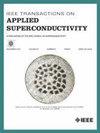Experimental Validation of a Scaling Law for the Critical Current of Commercial REBCO Tapes as a Function of Magnetic Field and Temperature
IF 1.7
3区 物理与天体物理
Q3 ENGINEERING, ELECTRICAL & ELECTRONIC
引用次数: 0
Abstract
Much information is lacking at present on the electrical properties of commercial REBCO tapes. This work, which builds on a previous paper of the same authors, presents the results of an experimental campaign aimed at deriving the critical current of tapes from SuperPower, Fujikura, Faraday Factory, and Shanghai Superconductor Technology. The campaign was conducted by applying both the transport method at 4.2 K, in perpendicular background magnetic fields of up to 15 T, and the magnetization method from 4.2 K up to the critical temperature in fields of up to 10 T. This latter method was adopted to determining the so-called crossover field,商用REBCO带临界电流随磁场和温度变化规律的实验验证
目前关于商用REBCO磁带的电性能的信息还很缺乏。这项工作建立在同一作者之前的一篇论文的基础上,提出了一项实验活动的结果,旨在从超级力量,藤仓,法拉第工厂和上海超导技术公司获得磁带的临界电流。在高达15 T的垂直背景磁场中,采用4.2 K的输输方法,在高达10 T的垂直背景磁场中采用4.2 K至临界温度的磁化方法。采用后一种方法来确定所谓的交叉场${{B}_0}$,在该交叉场中发生了从单个涡旋钉钉到集体钉钉的转变。由于涉及高电流,${{B}_0}$很难通过传输方法确定(在4.2 K时,${{B}_0}$大约为1 T,对应于4毫米磁带的1500 A以上的电流)。磁化测量证实了在4.2 K下的输运测量,包括低于${{B} 0}$和高达10 t的输运测量。进一步的高于4.2 K的磁化测量允许导出缩放参数的温度依赖性,以与不同制造商的磁钉增强方法相关。这提供了关于钉钉机制的有效性和相互作用的见解。
本文章由计算机程序翻译,如有差异,请以英文原文为准。
求助全文
约1分钟内获得全文
求助全文
来源期刊

IEEE Transactions on Applied Superconductivity
工程技术-工程:电子与电气
CiteScore
3.50
自引率
33.30%
发文量
650
审稿时长
2.3 months
期刊介绍:
IEEE Transactions on Applied Superconductivity (TAS) contains articles on the applications of superconductivity and other relevant technology. Electronic applications include analog and digital circuits employing thin films and active devices such as Josephson junctions. Large scale applications include magnets for power applications such as motors and generators, for magnetic resonance, for accelerators, and cable applications such as power transmission.
 求助内容:
求助内容: 应助结果提醒方式:
应助结果提醒方式:


